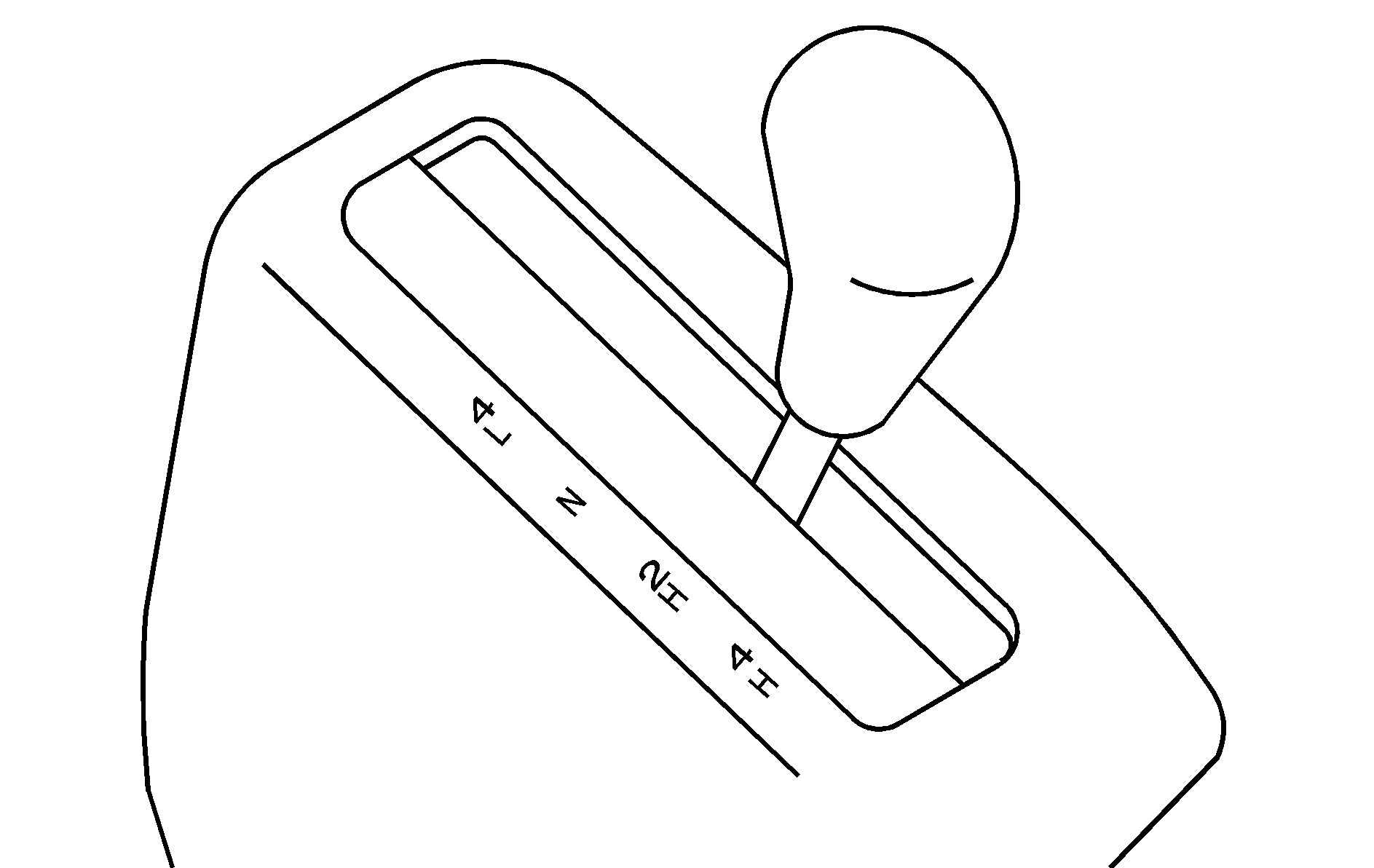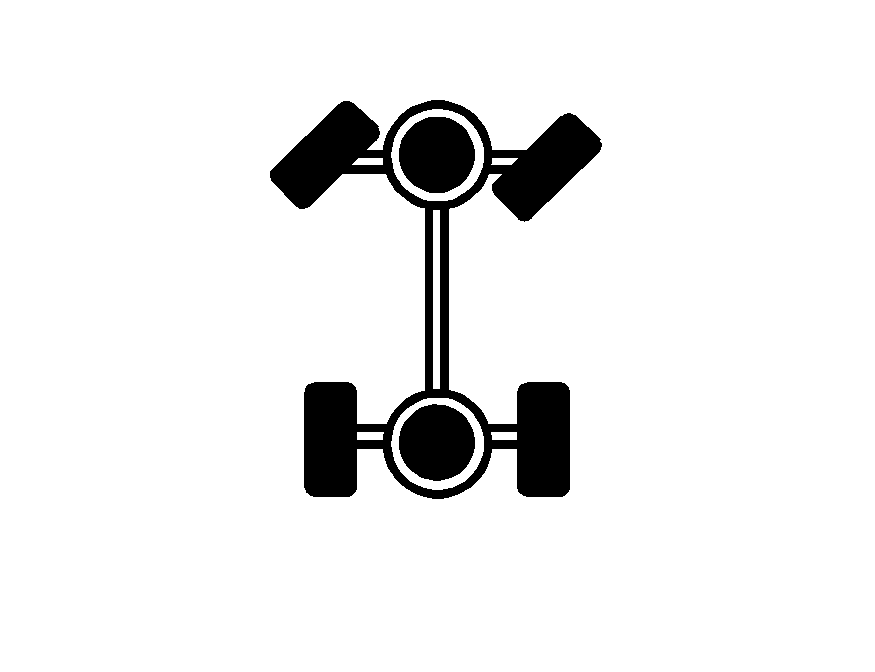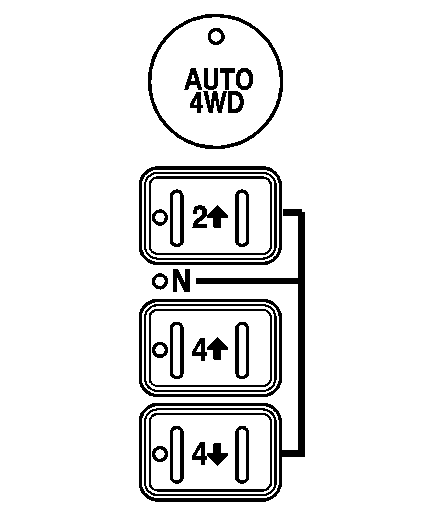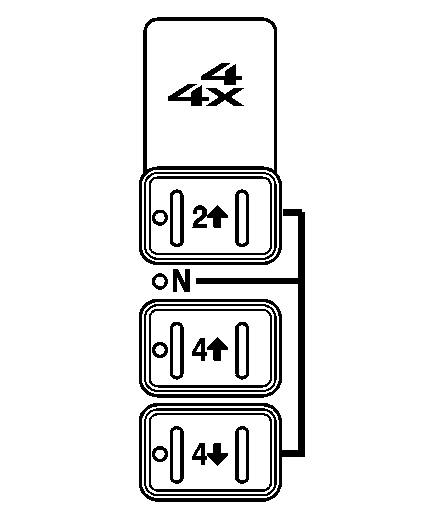| Table 1: | Recommended Transfer Case Settings |
| Table 2: | Recommended Transfer Case Settings |
| Table 3: | Recommended Transfer Case Settings |
If your vehicle has four-wheel drive, you can send your engine's driving power to all four wheels for extra traction. To get the most satisfaction out of four-wheel drive, you must be familiar with its operation. Read the part that follows before using four-wheel drive. See the appropriate text for the transfer case in your vehicle.
Notice: Driving on clean, dry pavement in four-wheel drive for an extended period of time can cause premature wear on the vehicle's powertrain. Do not drive on clean, dry pavement in Four-Wheel Drive for extended periods of time.
Front Axle Locking Feature
The front axle locks and unlocks automatically when you shift the transfer case. Some delay for the axle to lock or unlock is normal.
Manual Transfer Case

The transfer case shift lever is on the floor to the right of the driver. Use this lever to shift into and out of four-wheel drive.

A 4WD indicator light will illuminate when you shift into four-wheel drive and the front axle engages. See Four-Wheel-Drive Light .
Some delay between shifting and the indicator's lighting is normal.
| Transfer Case Settings | |||
|---|---|---|---|---|
Driving Conditions | 2HI | 4HI | 4LO | N |
Normal | YES |
|
|
|
Severe |
| YES |
|
|
Extreme |
|
| YES |
|
Vehicle in Tow* |
|
|
| YES |
*See Recreational Vehicle Towing or Towing Your Vehicle for further information. | ||||
An indicator on the bezel near the lever shows you the transfer case settings:
2-Wheel High (2HI): This setting is used for driving in most street and highway situations. Your front axle is not engaged in two-wheel drive. This setting also provides the best fuel economy.4-Wheel High (4HI): Use 4HI when you need extra traction, such as on snowy or icy roads or in most off-road situations. This setting also engages your front axle to help drive your vehicle. This is the best setting to use when plowing snow.
Caution: Shifting the transfer case to Neutral can cause the vehicle to roll even if the transmission is in P (Park), or if you have a manual transmission, even if you are in gear. You or someone else could be seriously injured. Be sure to set the parking brake before placing the transfer case in Neutral. See Parking Brake.
NEUTRAL (N): Shift to this setting only when your vehicle needs to be towed. See Recreational Vehicle Towing or Towing Your Vehicle .4-Wheel Low (4L0): This setting also engages your front axle and delivers extra torque. You may never need 4LO. It sends maximum power to all four wheels. You might choose 4LO if you are driving off-road in deep sand, deep mud, deep snow and climbing or descending steep hills. You can shift from 2-Wheel High (2HI) to 4-Wheel High (4HI) or from 4-Wheel High (4HI) to 2-Wheel High (2HI) while the vehicle is moving. Your front axle will engage faster if you take your foot off of the accelerator for a couple of seconds after you shift. In extremely cold weather, it may be necessary to stop or slow the vehicle to shift into 4-Wheel High (4HI).
When Using the Manual Transfer Case
| • | All shifts should be made using quick motions. Slow shifts may make it harder to shift. |
| • | You may notice that it is harder to shift when the vehicle is cold. When the vehicle warms up the shifting will return to normal. |
| • | While in 4-Wheel High (4HI) or 4-Wheel Low (4LO) you may experience reduced fuel economy. |
| • | Avoid driving in 4-Wheel Drive on clean, dry pavement. It may cause your tires to wear faster, and make your transfer case harder to shift and run noisier. |
Shifting from 2HI to 4HI
| • | Shifts between 2HI and 4HI can be made at any vehicle speed. |
| • | It is easiest to shift the transfer case when maintaining a constant speed or a slight acceleration. If possible, avoid shifting while slowing down, as it will may make it harder to shift. |
| • | Shift your transfer case lever in one continuous motion into either the 4HI or 2HI position. |
| • | In extremely cold weather, it may be necessary to slow or stop the vehicle to shift into 4HI until your vehicle has warmed up. |
| • | While in 4HI, your vehicle can be driven at any posted legal speed limit. |
Shifting In or Out of 4LO
Notice: Shifting the transfer case into Four-Wheel Drive Low while moving at speeds faster than 3 mph (5 km/h) may cause premature wear to the transfer case, and may cause the gears to grind. To avoid causing premature wear, and grinding the gears, do not shift the transfer case into Four-Wheel Drive Low while the vehicle is moving faster than 3 mph (5 km/h).
Shifts into 4LO can be made with the vehicle at a stop, or while slowly rolling about 1 to 3 mph (2 to 5 km/h).
| • | Shift the automatic transmission into NEUTRAL (N), or with a manual transmission, press the clutch pedal, or shift into NEUTRAL. |
| • | Shift the transfer case shift lever in one continuous motion into the 4LO position. |
| • | When in 4LO do not drive faster than 45 mph. This will reduce wear and extend the life of your transfer case. |
Shifting In or Out of NEUTRAL
- With the vehicle running and the engine at an idle set the parking brake.
- Place the transmission into NEUTRAL (N).
Shift the transfer case in one continuous motion into or out of the NEUTRAL (N) position.
Automatic Transfer Case

The transfer case buttons are located to the left of the instrument panel cluster.
Use these switches to shift into and out of four-wheel drive.
| Transfer Case Settings | ||||
|---|---|---|---|---|---|
Driving Conditions | 2HI | AUTO 4WD | 4HI | 4LO | N |
Normal | YES |
|
|
|
|
Variable |
| YES |
|
|
|
Severe |
|
| YES |
|
|
Extreme |
|
|
| YES |
|
Vehicle in Tow* |
|
|
|
| YES |
*See "Recreational Vehicle Towing" in the Index for further information. | |||||
You can choose among four driving settings:
AUTO 4WD: This setting is ideal for use when road conditions are variable. When driving your vehicle in AUTO 4WD, the front axle is engaged, but the vehicle's power is sent to the rear wheels. When the vehicle senses a loss of traction, the system will automatically engage four-wheel drive. Driving in this mode results in slightly lower fuel economy than 2HI.(2HI): This setting is used for driving in most street and highway situations. Your front axle is not engaged in two-wheel drive. This setting also provides the best fuel economy.
(4HI): Use 4HI when you need extra traction, such a on snowy or icy roads or in most off-road situations. This setting also engages your front axle to help drive your vehicle. This is the best setting to use when plowing snow.
(4LO): This setting also engages your front axle and delivers extra torque. You may never need 4LO. It sends maximum power to all four wheels. You might choose 4LO if you are driving off-road in deep sand, deep mud, deep snow and climbing or descending steep hills.
Caution: Shifting the transfer case to Neutral can cause the vehicle to roll even if the transmission is in P (Park). You or someone else could be seriously injured. Be sure to set the parking brake before placing the transfer case in Neutral. See Parking Brake.
NEUTRAL: Shift the vehicle's transfer case to NEUTRAL only when towing your vehicle. See Recreational Vehicle Towing or Towing Your Vehicle for more information.Indicator lights in the switches show which setting your transfer case is in. The indicator lights will come on briefly when you turn on the ignition and one will stay on. If the lights do not come on, you should take your vehicle to your dealer for service. An indicator light will flash while the transfer case is being shifted. It will remain illuminated when the shift is complete. If for some reason the transfer case cannot make a requested shift, it will return to the last chosen setting.
If the SERVICE 4WD message stays on, you should take your vehicle to your dealer for service. See DIC Warnings and Messages for further information.
Shifting into 4HI or AUTO 4WD
Press and release the 4HI or AUTO 4WD switch. This can be done at any speed (except when shifting from 4LO), and the indicator light will flash while shifting. It will remain illuminated when the shift is completed.
Shifting into 2HI
Press and release the 2HI switch. This can be done at any speed (except when shifting from 4LO).
Shifting into 4LO
To shift to 4LO, the ignition must be in RUN and the vehicle must be stopped or moving less than 3 mph (4.8 km/h) with the transmission in NEUTRAL (N). The preferred method for shifting into 4LO is to have your vehicle moving 1 to 2 mph (1.6 to 3.2 km/h). Press and release the 4LO switch. You must wait for the 4LO indicator light to stop flashing and remain illuminated before shifting your transmission in gear.
Notice: Shifting the transmission into gear before the Four-Wheel Drive Low indicator light has stopped flashing could damage the transfer case. To help avoid damaging the vehicle, always wait for the Four-Wheel Drive Low indicator light to stop flashing before shifting the transmission into gear.
It is typical for your vehicle to exhibit significant engagement noise and bump when shifting between 4LO and 4HI ranges or from NEUTRAL with the engine running.
If the 4LO switch is pressed when your vehicle is in gear and/or moving, the 4LO indicator light will flash for 30 seconds and not complete the shift unless your vehicle is moving less than 3 mph (4.8 km/h) and the transmission is in NEUTRAL (N). After 30 seconds the transfer case will shift to 4HI mode.
Shifting Out of 4LO
To shift from 4LO to 4HI, AUTO 4WD or 2HI your vehicle must be stopped or moving less than 3 mph (4.8 km/h) with the transmission in NEUTRAL (N) and the ignition in RUN. The preferred method for shifting out of 4LO is to have your vehicle moving 1 to 2 mph (1.6 to 3.2 km/h). Press and release the 4HI, AUTO 4WD or 2HI switch. You must wait for the 4HI, AUTO 4WD or 2HI indicator light to stop flashing and remain illuminated before shifting your transmission into gear.
Notice: Shifting the transmission into gear before the Four-Wheel Drive Low indicator light has stopped flashing could damage the transfer case. To help avoid damaging the vehicle, always wait for the Four-Wheel Drive Low indicator light to stop flashing before shifting the transmission into gear.
It is typical for your vehicle to exhibit significant engagement noise and bump when shifting between 4LO and 4HI ranges or from NEUTRAL with the engine running.
If the 4HI, AUTO 4WD or 2HI switch is pressed when your vehicle is in gear and/or moving, the 4HI, AUTO 4WD or 2HI indicator light will flash for 30 seconds but will not complete the shift unless your vehicle is moving less than 3 mph (4.8 km/h) and the transmission is in NEUTRAL (N).
Shifting into NEUTRAL
To shift the transfer case to NEUTRAL do the following:
- Make sure the vehicle is parked so that it will not roll.
- Set the parking brake.
- Start the vehicle or turn the ignition to RUN.
- Connect the vehicle to the towing vehicle.
- Put the transmission in NEUTRAL (N).
- Shift the transfer case to 2HI.
- Simultaneously press and hold the 2HI and 4LO buttons for 10 seconds. The red NEUTRAL light will come on when the transfer case shift to NEUTRAL is complete.
- Shift the transmission to REVERSE (R) for one second, then shift the transmission to DRIVE (D) for one second, or FIRST (1) for vehicles equipped with a manual transmission.
- Turn the ignition to LOCK.
- Place the transmission shift lever in PARK (P), or FIRST (1) for vehicles with a manual transmission.
- Release the parking brake prior to towing.
Shifting Out of NEUTRAL
To shift out of NEUTRAL:
- Set the parking brake and apply the regular brake pedal.
- Shift the transmission to NEUTRAL (N) and turn the ignition to RUN with the engine off.
- Press the button for the desired transfer case shift position (2HI, 4HI, AUTO 4WD or 4LO).
- After the transfer case has shifted out of NEUTRAL the red light will go out.
- Release the parking brake.
- You may start the engine and shift the transmission to the desired position.
Excessively shifting the transfer case into or out of the different modes may cause the transfer case to enter the shift protection mode. This will protect the transfer case from possible damage and will only allow the transfer case to respond to one shift per 10 seconds. The transfer case may stay in this mode for up to three minutes.
Electronic Transfer Case

If your four-wheel-drive vehicle has the electronic transfer case, the transfer case switches are located to the left of the instrument panel cluster.
Use these switches to shift into and out of four-wheel drive. You can choose among three driving settings:
| Transfer Case Settings | |||
|---|---|---|---|---|
Driving Conditions | 2HI | 4HI | 4LO | N |
Normal | YES |
|
|
|
Severe |
| YES |
|
|
Extreme |
|
| YES |
|
Vehicle in Tow* |
|
|
| YES |
*See Recreational Vehicle Towing or Towing Your Vehicle for further information. | ||||
(4HI): This setting engages your front axle to help drive your vehicle. Use 4HI when you need extra traction, such as on snowy or icy roads, or in most off-road situations.
(4LO): This setting also engages your front axle to give you extra traction. You may never need 4LO. It sends the maximum power to all four wheels. You might choose 4LO if you were driving off-road in sand, mud or deep snow and climbing or descending steep hills. Indicator lights in the switches show you which setting you are in. The indicator lights will come on briefly when you turn on the ignition and the last chosen setting will stay on. If the lights do not come on, you should take your vehicle in for service. An indicator light will flash while shifting. It will remain illuminated when the shift is completed. If for some reason the transfer cannot make a requested shift, it will return to the last chosen setting.
Caution: Shifting the transfer case to Neutral can cause the vehicle to roll even if the transmission is in P (Park). You or someone else could be seriously injured. Be sure to set the parking brake before placing the transfer case in Neutral. See Parking Brake.
NEUTRAL: Shift the vehicle's transfer case to NEUTRAL only when towing your vehicle. See Recreational Vehicle Towing or Towing Your Vehicle for more information.Shifting from 2HI to 4HI
Press and release the 4HI switch. This can be done at any speed, and the front axle will lock automatically with some delay.
Shifting from 4HI to 2HI
Press and release the 2HI switch. This can be done at any speed, and the front axle will unlock automatically with some delay.
Shifting from 2HI or 4HI to 4LO
To shift from 2HI or 4HI to 4LO, the vehicle must be stopped or moving less than 3 mph (4.8 km/h) with the transmission in NEUTRAL (N). The preferred method for shifting into 4LO is to have your vehicle moving 1 to 2 mph (1.6 to 3.2 km/h). Press and release the 4LO switch. You must wait for the 4LO indicator light to stop flashing and remain illuminated before shifting your transmission into gear.
Notice: Shifting the transmission into gear before the Four-Wheel Drive Low indicator light has stopped flashing could damage the transfer case. To help avoid damaging the vehicle, always wait for the Four-Wheel Drive Low indicator light to stop flashing before shifting the transmission into gear.
If the 4LO switch is pressed when your vehicle is in gear and/or moving, the 4LO indicator light will flash for 30 seconds and not complete the shift unless your vehicle is moving slower than 3 mph (4.8 km/h) and the transmission is in NEUTRAL (N). The transfer case will shift to 4HI while waiting to complete the shift.
Shifting from 4LO to 4HI or 2HI
To shift from 4LO to 4HI or 2HI, your vehicle must be stopped or moving less than 3 mph (4.8 km/h) with the transmission in NEUTRAL (N). The preferred method for shifting out of 4LO is to have your vehicle moving 1 to 2 mph (1.6 to 3.2 km/h). Press and release the 4HI switch. You must wait for the 4HI indicator light to stop flashing and remain illuminated before shifting your transmission into gear.
If the 4HI switch is pressed when your vehicle is in gear and/or moving, the 4HI indicator light will flash for 30 seconds but will not complete the shift unless the vehicle is moving slower than 3 mph (4.8 km/h) and the transmission is in NEUTRAL (N).
Shifting into NEUTRAL
To shift the transfer case to NEUTRAL, first make sure the vehicle is parked so that it will not roll:
- Set the parking brake.
- Start the vehicle or turn the ignition to RUN.
- Connect the vehicle to the towing vehicle.
- Put the transmission in NEUTRAL (N).
- Shift the transfer case to 2HI.
- Simultaneously press and hold the 2HI and 4LO buttons for 10 seconds. The red NEUTRAL light will come on when the transfer case shift to NEUTRAL is complete.
- Shift the transmission to REVERSE (R) for one second, then shift the transmission to DRIVE (D) for one second, for FIRST (1) for vehicles equipped with a manual transmission.
- Turn the ignition to LOCK.
- Place the transmission shift lever in PARK (P), or FIRST (1) for vehicles equipped with a manual transmission.
- Release the parking brake prior to towing.
Shifting Out of NEUTRAL
To shift out of NEUTRAL:
- Set the parking brake and apply the regular brake pedal.
- Shift the transmission to NEUTRAL (N) and turn the ignition to RUN with the engine off.
- Press the button for the desired transfer case shift position (2HI, 4HI, or 4LO).
- After the transfer case has shifted out of NEUTRAL the red light will go out.
- Release the parking brake.
- You may start the engine and shift the transmission to the desired position.
Excessively shifting the transfer case into or out of the different modes may cause the transfer case to enter the shift protection mode. This will protect the transfer case from possible damage and will only allow the transfer case to respond to one shift per 10 seconds. The transfer case may stay in this mode for up to three minutes.
